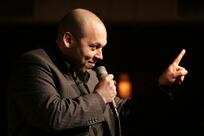It is that time of the year known as the 'Awards Season'; stand by for 'Golfer of the Year' (Padraig Harrington?), 'Athlete of the Year' (Usian Bolt?), 'Driver of the Year' (tricky one that!) right down to 'Elephant Polo Team of the Year' (which should go to England courtesy of their victory in the world championship in Nepal two weeks ago...).
As the year 2000 approached, I was commissioned to write an article on the 'Top 10 Sportsmen of the Century'; nine years on, have the names on that list survived the passage of time or have any of the new kids on the sporting blocks forced their way into my elite? Well, nothing has changed at the top where Muhammad Ali still rules supreme. As the man, himself, said: "People don't realise what they had 'til it's gone. Like President Kennedy - nobody like him. Like The Beatles, there will never be anything like them. Like my man, Elvis Presley - I was the Elvis of boxing."
Ali transcended the ring to become the most recognisable man on the planet. Kennedy, The Beatles, even Elvis, were unknown in many parts of Africa and Asia, whereas Ali's legend spread across the map of the world like an empire. Even seeing Ali now, a slow-moving, slow-talking shell cruelly reduced by disease, it is impossible not to remember him as he was then; the two improbable dramas with Sonny Liston, the three wars with Joe Frazier, the Rumble in the Jungle against George Foreman.
"I Am the Greatest!" Ali proclaimed. He was, and will forever remain so. "I Am the Second Greatest" may lack a certain resonance, but given Ali's achievements, popularity and influence, I think Pele would accept the runners-up medal as the honour it is intended to be. While acknowledging the claims of Johann Cruyff, Alfredo di Stefano, Diego Maradona and George Best, it was Pele who described football as "the beautiful game" and no one played it more beautifully more often. On every occasion he came into possession of the ball it was Show Time!; you came to expect the unexpected and rarely were you disappointed. Scorer of over 1,000 goals, I will forever remember Pele for the "goal" he did not score against Uruguay in the 1970 World Cup semi-final when, after dummying goalkeeper Mazurkiewicz, he hooked the ball millimetres wide from an acute angle. So outrageous was the manoeuvre, legend has it that hours after the match, a crazed Mazurkiewicz could be seen opening cupboards in the bowels of the stadium muttering: "Where did he go?"
If you have never watched baseball or read the sport's folklore, then my third-placed pick will appear incongruous, but it was Babe Ruth who transformed the game into America's national pastime. With his piggy eyes, bulbous nose, flabby torso and sparrow's legs, Ruth was an unlikely sporting hero, yet like Ali and Pele, his arrival at the batting plate sent a shiver of expectation through the audience.
The bare statistics - as mightily impressive as they are - are an irrelevance; suffice to say over 50 years after his death, Ruth remains as much a part of American history as Paul Revere. A physical giant with a gargantuan appetite for bourbon, women and hot dogs, the Home Run King was idolised by every child and down-and-out alike. At his peak in 1930, Ruth's salary from the New York Yankees was $80,000 (Dh294,000) - $5,000 more than President Hoover received.
Such was his fame that the Japanese fighter pilots who attacked Pearl Harbour painted the battle-cry To Hell With Babe Ruth on their wing tips. Forget George Washington, Frank Sinatra, Neil Armstrong, Babe Ruth remains America's most popular figure. Having grown up in working-class Glasgow where cricket was marginally less popular than flower-arranging in my gang, I have spent much of my personal half-century plus living in ignorance of Don Bradman. My education was supplied by the late Colin Cowdrey, who persuaded me that The Don was cricket's Babe Ruth.
Even I am impressed by a Test average of 99.94 (especially in an era when the England XI find it a struggle to reach that total collectively), although Bradman himself was firmly of the belief he could have done even better. "If I'd had the opportunity of playing against India, Pakistan and Sri Lanka, I rather think I would have increased my average." If Arnold Palmer did more than anyone to popularise golf, then it was Jack Nicklaus who became the game's champion of champions.
Judged solely by his tally of majors, the Golden Bear is supreme, winning more titles than Hogan and Tom Watson put together, more than Player and Palmer put together, more than Jones and Sam Snead put together. Positions 6-10 produced a blanket finish; basketball's Michael Jordan, the first globally admired superstar who happened to be black rather than a black superstar; Jesse Owens, who made a nonsense of Hitler's sick sense of Aryan superiority; Rod Laver, the finest tennis player who ever lived and the game's most gracious champion; Gary Sobers, cricket's greatest all-rounder (my thanks again to Lord Cowdrey for introducing me to his genius); and at No 10, Jim Clark, F1's greatest champion.
The two outstanding male athletes of this millennium have been Tiger Woods and Roger Federer; Woods has won 12 'majors' since 2000 (taking his total to 14) while Federer has amassed 14 'grand slam' tennis titles. But have they done enough to dislodge Jack Nicklaus and Rod Laver? I think not; the Tiger is still four short of the Golden Bear's record 18 majors while Federer has yet to win the French Open on clay.
No doubt you will have your own opinions on the matter... rphilips@thenational.ae




